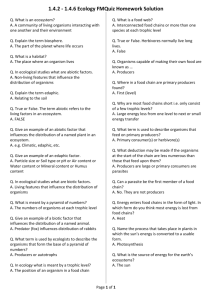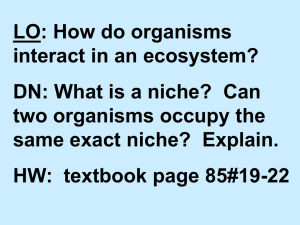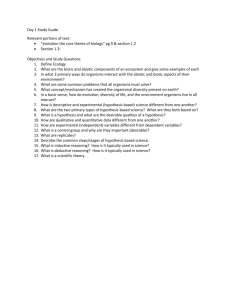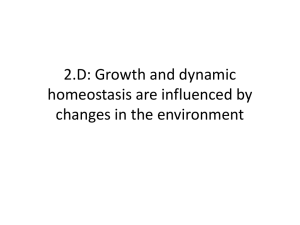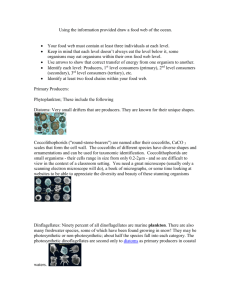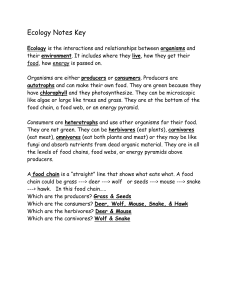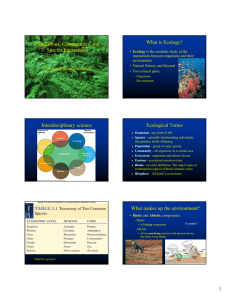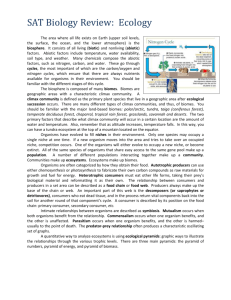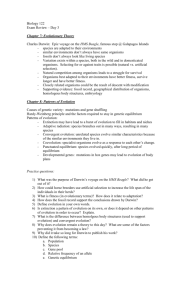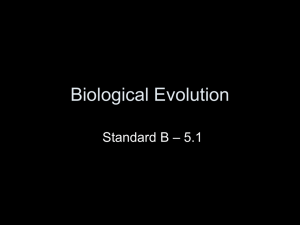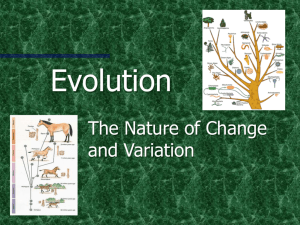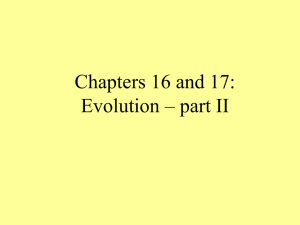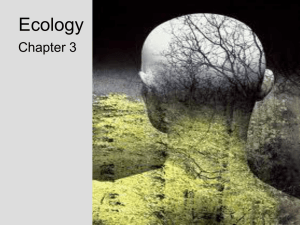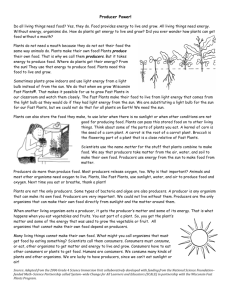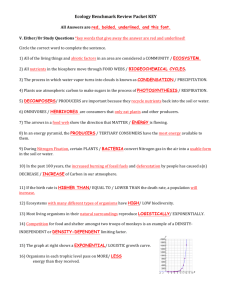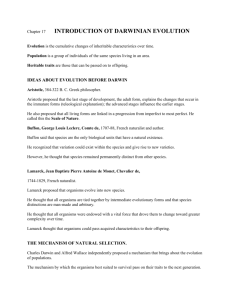File
advertisement
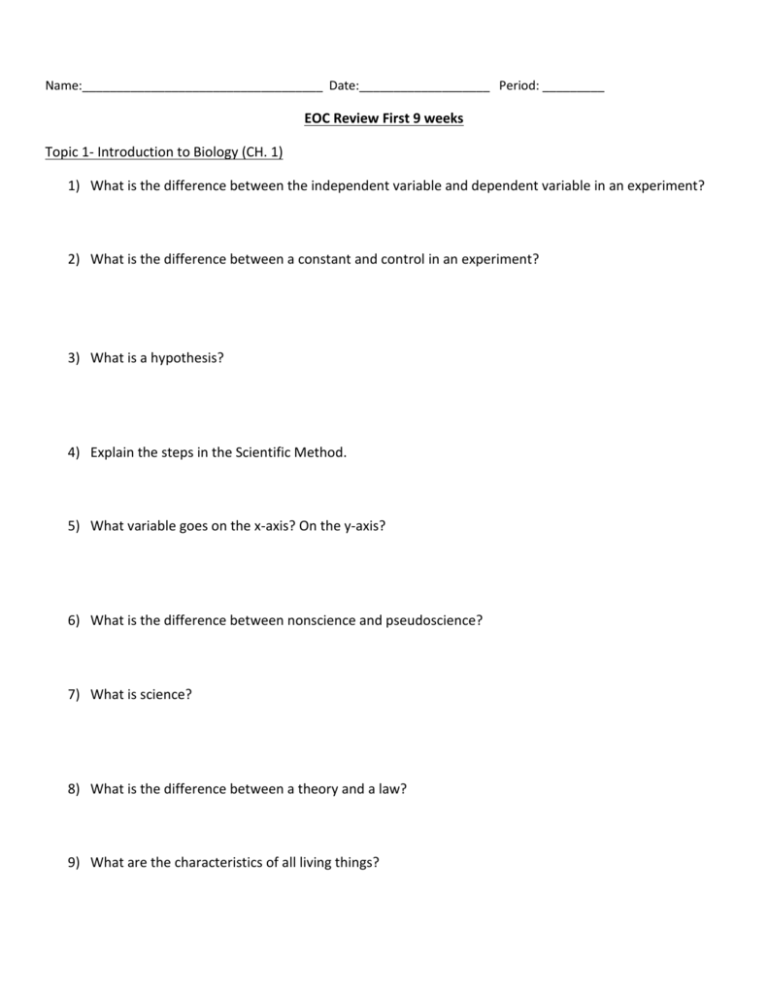
Name:___________________________________ Date:___________________ Period: _________ EOC Review First 9 weeks Topic 1- Introduction to Biology (CH. 1) 1) What is the difference between the independent variable and dependent variable in an experiment? 2) What is the difference between a constant and control in an experiment? 3) What is a hypothesis? 4) Explain the steps in the Scientific Method. 5) What variable goes on the x-axis? On the y-axis? 6) What is the difference between nonscience and pseudoscience? 7) What is science? 8) What is the difference between a theory and a law? 9) What are the characteristics of all living things? Topic 2 – Ecology-Ecosystems (CH. 3.1, 4.1-4.5, 6.3, 6.4) 10) Define mutualism and give an example. 11) Define parasitism and give an example. 12) Define commensalism and give an example. 13) Make a flowchart with all levels of organization of the living matter (largest to smallest) 14) Make a flowchart with the flow of energy through an ecosystem (start with the sun) 15) What organisms are called producers in a food chain? 16) What organisms are called consumers in a food chain? 17) What do you call a group of organisms of one type living in the same place at the same time? 18) Classify the following environmental factors into biotic (B) and abiotic (A). A. Plant life ____ E. Sunlight ____ B. Soil type ____ F. Bacteria ____ C. Rainfall ____ G. Fungi _____ D. Temperature ____ H. Lions ______ 19) What are abiotic and biotic factors? 20) The relationship between two species living closely together is called _______________________ 21) What are density-dependent factors? 22) What are density-independent factors? 23) Place the factors in the appropriate place in the chart. Predators, parasites, earthquakes, hurricanes, competition for food, fires, deforestation, freezing temperatures, abundance of prey, extremely hot summers. Density dependent Density independent Topic 3– Population in an Ecosystem (CH. 5) 24) What kind of population growth is shown in the graph below? 25) In the graph above, t represents time and X represents number of organisms. What does M represent? 26) Draw and label an exponential growth curve. 27) Immigration makes a population (grow, decrease) and emigration makes a population (grow, decrease). Circle the right answer. 28) Under each graph above, write what will be the expected population size in 30 years. Use words like LARGER, SMALLER, THE SAME. 29) What does "carrying capacity" mean? 30) How does the birth rate compare to the death rate when the carrying capacity of the environment is reached? 31) Define population. 32) Define population density 33) When does the population grow faster? Topic 4– Ecology –Energy Flow (CH. 3) 34) Draw a food pyramid. Label each level (producers,primary consumer, secondary consumers, tertiary consumers) The following questions refer to the picture above: 35) Based on the food web above, draw a food chain? 36) Which animals have direct access to the producers? 37) Which organisms are the decomposers? 38) Which is the top predator of the web? 39) Draw the missing arrows of the mouse and the beetle. 40) What would happen if all the rabbits die? 41) If the producers make 1’000,000 calories, how many calories are available to the consumers at the top of the pyramid? Show work. Topic 5– Human Impact on Environment Flow (CH. 6) 42) What do you call that process below? 43) What is renewable resource? Give examples. 44) What is non-renewable resource? Give examples. 45) What is an invasive species? 46) What are some examples of air pollution? 47) Define eutrophication. 48) Study the energy pyramid. If a pesticide is applied to the plants, and tissues from the animals are studied in a lab, where would the pesticide be more concentrated? Topic 23 & 24 (CH. 2.1,2.3,2.4) 49) Define polymer: 50) Name two functions of carbohydrates and give an example of each. 51) Monosaccharides have single molecules, disaccharides have __________ molecules and polysaccharides have ____________ sugar units bound together . 52) What is the ration of carbon, hydrogen, and oxygen in a carbohydrate? 53) Starch is found only in______________ while glycogen belongs only to __________ 54) Proteins are polymers of _____________ 55) Draw a protein 56) Name the functions of proteins 57) What is the only macromolecule that is not a polymer? 58) What are the three functions of lipids? 59) What are the three types of lipids? Give an example of each. 60) What makes up a nucleotide? 61) Draw a nucleotide. 62) Draw glucose. 63) What is the function of nucleic acids? 64) What will most likely happen if an appropriate enzyme is added to a chemical reaction? 65) The human body maintains a temperature of around 98.6 degrees at all times. Enzymes are involved in almost every chemical reaction in the body. Describes the connection between these two statements? 66) The enzyme lactase will break down the sugar lactose into what? 67) Draw an energy releasing reaction. Then on the same graph using a dotted line draw the same reaction if an enzyme was added. Topic 6– Evolution-Origins of Life (CH. 19.3) 68) What is evolution? 69) Compare the primitive and the present atmosphere. Refer to gas composition. 70) How did the life originate in oceans? 71) Where did life appear at first? 72) What were the energy sources that powered the chemical reactions that originated life? 73) The first cells were (autotrophic, heterotrophic). 74) Explain endosymbiotic theory 75) Fill in the chart below. Scientist What they contributed to the origin of life Pasteur Oparin Miller/Urey Margulis Fox Topic 7- Evolution- Theory of evolution (CH. 16.4, 26.3) 76) Name the proofs of evolution? 77) What are vestigial structures and give an example? 78) What are homologous structures and give an example? 79) What are analaogous structures and give an example? 80) Fill in the chart below: Terms How do the following terms support the Theory of Evolution? Fossil record Comparative anatomy Comparative embryology Biogeography Molecular biology Observed Evolutionary change 81) Name the characteristics of primates. 82) Are humans primates? 83) Along the human evolutionary line, the size of the face (increases, decreases) and the size of the brain (increases, decreases). 84) In the process of evolution of man, there was a species that originated two branches, the genus Australopithecus (extinct) and the genus Homo (the present man). The first skeleton of that species was named after a song by The Beatles. What is that species? 85) Which of the following species used tools, lived in groups and have a primitive type of religion? Circle the right answer (s) H. neanderthalensis A. afarensis 86) Topic 8- Mechanisms of Evolution (CH.16.1-16.3, 17.2-17.3) 87) Match: Malthus Evolution by natural selection Lamarck Geological events shaped the Earth Lyell Populations grow exponentially originating competition Darwin Inheritance of acquired traits 88) Who is the father of evolution? 89) What is genetic drift? 90) What are the two forms of genetic drift? 91) Define punctuated equilibrium. Is this an example of microevolution or macroevolution? 92) Define gradualism. Is this an example of microevolution or macroevolution? 93) Define species. 94) Define adaptation 95) Define natural selection. 96) What did Darwin imply when he came up with the phrase “Descent with modification”? 97) What are the conditions needed for natural selection to occur. 98) What is the difference between background and mass extinction? 99) What is the sequence of events in the evolution of species? Mutation → → → 100) Draw the graphs of stabilizing, directional and disruptive selection and explain each. 1 1 1 0 0 0 a) Stabilizing: b) Directional c) Disruptive 101) Define adaptive radiation and give an example. 102) Define convergent evolution and give an example. 103) Define coevolution and give an example. 104) Name and explain the 3 types of reproductive isolation. 105) Arrange in a logical sequence the events that explain Darwin’s Theory of Evolution: a. Competition is fierce among members of different species. b. Populations often increase rapidly and without warning. c. Resources become limited over long periods of time. d. Some organisms survive and reproduce better than others.
